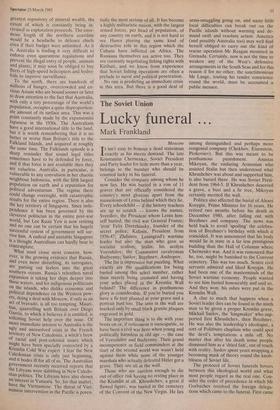The Soviet Union
Lucky funeral ...
Mark Frankl and
Moscow It isn't easy to honour a dead statesman exactly as his merits demand. The late Konstantin Chernenko, Soviet President and Party leader for little more than a year, belongs to the number who should be counted lucky in his funeral.
Consider the company among whom he now lies. He was buried in a row of 11 graves that are officially considered the country's most glorious apart from the mausoleum of Lenin behind which they lie. Every schoolchild — if the history teachers are up to scratch — knows the names. Sverdlov, the President whom Lenin him- self buried; the civil war General Frunze; `iron' Felix Dzerzhinsky, founder of the secret police; Kalinin, President from 1936-47; Zhdanov, Leningrad's wartime leader but also the man who gave us socialist realism; Stalin; his acolyte Voroshilov; the Communist cavalryman Budyenny; Suslov; Brezhnev; Andropov. The list is impressive but puzzling. What exactly are the qualifications for being buried among this select number, rather than merely being cremated and having your ashes placed in the Kremlin Wall behind? The difference in posthumous glory is considerable. If you're buried you have a fir tree planted at your grave and a portrait bust too. The urns in the wall are marked only by small black granite plaques engraved in gold. The important thing is to die with your boots on or, if retirement is inescapable, to have been a civil war hero when .young and politically harmless in old age — the case of Voroshilov and Budyenny. Their grand incompetence as field commanders at the start of the second world war wasn't held against them while none of the younger marshals who actually defeated Hitler got a grave. They are all in the wall. Those who are careless enough to die out of office risk having no resting place in the Kremlin at all. Khrushchev, a great if flawed figure, was buried in the cemetery of the Convent of the New Virgin. He lies among distinguished and perhaps more congenial company (Chekhov, Eisenstein, Prokoviev). But this was meant to be posthumous punishment. Anastas Mikoyan, the enduring Armenian who assisted Stalin but then understood what Khrushchev was about and supported him, is also buried there. He was Soviet Presi- dent from 1964-5. If Khrushchev deserved a grave, a bust and a fir tree, Mikoyan certainly merited the wall.
Politics also affected the burial of Alexei Kosygin, Prime Minister for 16 years. He retired two months before his death in December 1980, after falling out with Brezhnev and company. The news was held back to avoid 'spoiling' the celebra- tion of Brezhnev's birthday with which it coincided. It was announced that his body would lie in state in a far less prestigious building than the Hall of. Columns where Chernenko was. And it was rumoured that he, too, might be banished to the Convent cemetery. This was too much. Senior civil servants admired and liked Kosygin. He had been one of the masterminds of the Soviet wartime economy. People wanted to see him buried honourably and said so. And they won: his ashes were put in the Kremlin Wall.
A clue to much that happens when a Soviet leader dies can be found in the ninth man to be given a proper Kremlin grave, Mikhail Suslov, the 'kingmaker' who sup- ported first Khrushchev, then Brezhnev. He was also the leadership's ideologist, a sort of Politburo chaplain who could spot the devil's temptations a mile off. No matter that after his death some people dismissed him as a 'dried fish', out of touch with reality. Suslov spent years wrapping a becoming mask of theory round the knob- bliness of Soviet life.
The protocol of Soviet funerals hovers between this ideological world and what most people regard as the real one. Con- sider the order of precedence in which Mr Gorbachev received the foreign delega- tions which came to the funeral. First came the Warsaw Pact and candidate members of the Soviet bloc (Ethiopia, Cambodia, Nicaragua and so on). Then ideology took over. The modest Mr Gordon McLennan, general secretary of the CPGB, approached the head of the receiving line, grinning as he passed Mrs Thatcher. The leaders of the two scrapping Spanish Par- ties stepped in front of young Mr Gon- zales. And so it went on. There was a Mr Jackson from the American Party, a wisely anonymous gentlemen from Iraq, Mr Vas- salo, leader of the Maltese Communists. The other world, beginning alphabetically with a minister from the Australian government, got to shake the leader's hand only after Romesh Chandra, president of the World Peace Council.
Mr Suslov's ideological world came less well out of those moments when human mortality intervened. It's customary for the Russian Orthodox Church to pay its re- spects to a dead Soviet leader. Pimen, Patriarch of Moscow and All Russia, appeared in the Hall of Columns in black robes and white topped with a cross, an odd sight, as though a character from Boris Godunov had strolled across from the Bolshoi.
Pimen had no business at the burial proper but neither Suslov nor anyone else has come up with Communist words for that difficult moment when the body is laid in the earth. There is the sound of the gravediggers' new spades biting into frozen soil, there are quiet words of command from the supervising officers of the KGB troops who garrison the Kremlin, but otherwise silence. Ideology copes better with monuments than mortal bodies.















































 Previous page
Previous page